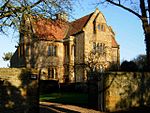Blisworth Rectory Farm Quarry
Geological Conservation Review sitesSites of Special Scientific Interest in Northamptonshire

Blisworth Rectory Farm Quarry is a 1.0-hectare (2.5-acre) geological Site of Special Scientific Interest west of Blisworth in Northamptonshire. It is a Geological Conservation Review site.This site exposes White Limestone dating to the Middle Jurassic Bathonian stage, around 165 million years ago. Common fossils are brachiopods, corals and gastropods, and there are also nautiloids and vertebrate teeth.The site is on private land with no public access.
Excerpt from the Wikipedia article Blisworth Rectory Farm Quarry (License: CC BY-SA 3.0, Authors, Images).Blisworth Rectory Farm Quarry
Towcester Road,
Geographical coordinates (GPS) Address Nearby Places Show on map
Geographical coordinates (GPS)
| Latitude | Longitude |
|---|---|
| N 52.171 ° | E -0.954 ° |
Address
Towcester Road
Towcester Road
NN7 3DL , Tiffield
England, United Kingdom
Open on Google Maps







